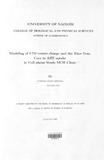| dc.description.abstract | HIV/ AIDS still remains the biggest social, economic and development challenge. UNAIDS
(2005), estimates that 2 million of Kenya's 29.5 million people are currently infected with HIV
and that l.5 million have succumbed to the disease, resulting in an overall decline in life expectancy
by 13 years. This trend is repeated in most sub-Saharan Africa countries. Our overall objective of
this project is to model the health status of patients after start of ARVS. This study revealed that
time to starting ARVs, the month the CD4 + cell count was done and occupation of the patient do
significantly influence the increase of CD4 T cells in the future, after start of taking A RVS. Besides
this, we saw that once a patient start taking ARVS, as expected their health does improve over time,
since increase in CD4 T cells is also significantly influenced by time since start of ARVS. Kaplan
Meier estimate for time to ARV initiation shows that overall patients were getting started after short
time of enrollment in the study. The time to ARV for males was shorter than that of the female . | |

